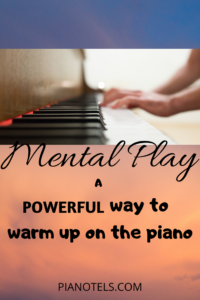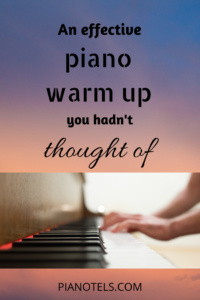When you sit down at the piano, you may want to begin your practice with some warm-ups. The following exercises are designed to help you build finger dexterity, finger strength, wrist flexibility, technicality, training the brain, and increasing knowledge of piano. There may be some exercises you have never heard of!
The first 15 minutes of your practice can be some of the best parts of your practice because piano is a brain exercise, and the first fifteen minutes of your practices is where your brain is fresh, active, ready to go, and not worn out. So use those 15 minutes wisely! Some of these exercises can also be thrown in between your practice as a “brain break” because it is done more by rote than by brain power.

Sight Reading: Learning Technicality through Application
Purpose: to increase technicality through application; increases sight reading skills
Piano Level: suggested for all levels
For use as: a warm-up
Sight reading is probably one of my most strongly suggested ways of warming up. Piano is a brain exercise, and sight reading engages the brain immediately and has wonderful benefits. When you sight read, you not only gain the skills of sight reading, you can also learn technicality in real life application.
One thing you need to recognize in exercises like Hanon, scales, and arpeggios is that it becomes rote. You do it enough that the brain no longer functions in the same way. It moves it to muscle memory. Your brain then plays the notes because it remembers where the fingers should be placed, not because the brain is truly engaged actively.
Thus, sight reading engages the brain in a most effective way. The brain needs to work through the note, read ahead, notice patterns and apply them, and the fingers learn dexterity along the way. It is by far one of the most interesting ways of learning finger dexterity. Especially if you use sight read some of the classics.
Music with Bach, Mozart, or Beethoven are excellent for teaching dexterity and technicality. I would strongly suggest songs like Bach’s Invention 1 or Bach’s Invention 08. You need to pick music that is easy enough to sight read, but still requires a bit of a challenge to play.
If you are on an intermediate level, I would suggest this book for sight reading: World’s Greatest Classic Themes.
PLEASE NOTE: if you are sight reading, a key element of making the most use of this, is to make sure that you are playing it as close to 100% correct the first time you play it. Sight reading in this manner requires slow, deliberate, and PERFECT practice (or as close to perfect as you possibly can get it). This is also how you should be learning any and all music, so it is an excellent idea to implement this in your sight reading warm-ups.
Mental Play: A Powerful Tool!
Purpose: to increase finger strength, dexterity, technicality, and wrist flexibility
Piano Level: suggested for all levels except early beginners
For use as: a warm-up, in between practice, and/or after practice

Piano is one of the few activities that engages all the areas of the brain at once. Because of this, piano has a great deal to do with using that brain power in a way that will benefit you the best in your playing. A fabulous way to warm-up, one that is highly suggested and proven to show beneficial results, is to mentally play through your music.
What this means is that before you place your hands on the keyboard, you mentally play through the song or the parts of the song that you will be playing. Imagine your hands on the keyboard, how they will move, what fingers will be used, what notes will be played. Imagine flawlessly playing through the piece or the part of the song that will be practiced.
If you need to look at the music, you can. But eventually you should get to the stage of not needing to look at your music and you can read the music and play the piece in your mind’s eye. The parts of the music that you do not know as well will become apparent quickly and you will know the places you will need to work on. Take note of those things that you will work on in your practice.
Mental play is also important for performing. Imagining oneself standing before an audience and performing is a powerful tool in preparing for those moments. The more the brain can imagine that performance done successfully, them more likely that it will performed just as imagined.
Not much has been said about the importance and the influence the brain and things like mental play can have on a pianists ability and success. Try out this mental play and see just how much of a difference it can make!
Hanon
Purpose: to increase finger strength, dexterity, technicality, and wrist flexibility
Piano Level: suggested for all levels except early beginners
For use as: a warm-up, during practice, or after practice
Hanon created exercises to help you build finger strength. Each exercise is designed to build strength in one or more fingers. The fourth and fifth fingers can be the weakest fingers in piano and Hanon does a good job about strengthening those tendons! The wrist is also exercised as you work through these.
Hanon is an exercise that uses very little brain power. It becomes a rote exercise. Thus, I would recommend it in between your practice as a bit of a “brain break”. Your fingers will need their dexterity and strength, so I do recommend something like Hanon to help with that. But I would not suggest it as the first thing you do when you warm-up, simply because you will want to save the first part of your practice for something that requires more brain power.
Here is what I would recommend if you are interested in Hanon. The reason I like this book over others is because it is spiral bound, which allows you to lay it flat when practicing.
Scales: Major and Relative Minor
Purpose: to increase technicality, finger dexterity, and wrist flexibility; also good for familiarizing with key signatures
Piano Level: suggested for all level except for primer
For use as: a warm-up, during practice, or after practice
Playing your scales, up and down, parallel and contrary, is an exercise not only for the fingers, but for the brain as well. Especially in the beginning, the fingers and the brain will need to coordinate sharps and flats in order to get the right scale in the appropriate key signature. But after time, it will become a rote exercise as well.
For a warm up, or for a brain break in between playing, I play my scale in contrary motion up and down 2 octaves using a metronome. Playing a scale contrary means to begin on a note, such as C for C Major, the right hand moves up the scale, the left hand moves down the scale. Playing in contrary motion allows for the left and right fingers to mirror each other and they play the same fingering the whole time.
After playing contrary, switch to parallel motion. This allows the fingers of each hand to learn to play independently.
After playing the major scale, do the same exercise with the relative minor. These exercises really help to imprint the sharps and flats into the brain for each key signatures.
I would suggest this exercise for both beginners and advanced players. I have a young player of age 6 who can play her scales both parallel and contrary, both hands together. She has not yet learned all of her scales, but she practices with the ones that she does know.
The very first thing she learned in her scales was to play contrary motion starting with both thumbs on C. She would just play the pentascale up, down, up, and down. Eventually she learned the full scale with the correct fingering on her right hand. Then she learned the left hand. Then she finally was able to do a full scale up and down in parallel motion hands together.
Arpeggios
Purpose: to increase technicality, finger dexterity, but is a huge help in wrist flexibility; also good for familiarizing with key signatures
Piano Level: suggested for later beginner to advanced
For use as: a warm-up, during practice, or after practice
Arpeggios are similar to scales. But the reason arpeggios become important to practice is because it is one of the best exercises for wrist flexibility. You play each arpeggio up and down the piano – at least 4 octaves at a time. Hands together and hands separate. The arpeggios help familiarize the pianist with the key signatures as well, but the movement that is required to go up and down on those arpeggios really causes the wrist to work at flexibility.
It is important to play arpeggios in legato so that the wrist can learn flexibility. While playing arpeggios, try to loosen up the wrist as much as possible. You do not want tension in the forearm during this exercise.
Transposing
Purpose: to exercise the brain in playing the piano; increases familiarity with key signatures
Piano Level: suggested for later beginner to advanced
For use as: a warm-up or during practice
Taking a song and transposing it is another way to warm-up. This will require you to fully engage your brain as you mentally transpose a piece from one key to another and play it as you go. Transposing a key is something that you can do with a piano piece that you may already know. So I would suggest taking a piece that you are already familiar with, you consider fairly easy, and transposing it.
This exercise will help to familiarize yourself with key signatures. Another benefit is that it causes you to study the composition of the piece and helps you to recognize patterns. These patterns can be found in multiple pieces of music. Therefore, you will want to be able to pick up on these patterns in your help of sight reading.
Flashcards
Purpose: to increase knowledge
Piano Level: any level
For use as: a warm-up, during practice, or after practice
A great way to warm up in piano is to simply get the brain thinking about piano. Using flashcards, playing the notes or music when appropriate, can be a valuable warm-up.
By remembering these concepts, notes, chords, theory, or whatever it is that you are quizzing yourself with, will help you as you begin your practice. Those new concepts will be fresh on your mind as you practice.
Warm Your Hands
Purpose: to bring warmth to your hands
Piano Level: any level
For use as: a warm-up, especially valuable before a performance

You may not have thought of this, but when your hands are warm, your muscles and tendons provide greater flexibility. The warmth in your hands could help you avoid mistakes as they are easier moved around. Warming your hands can be as simple as rubbing your hands together, stretching them out, holding them next to some heat, or putting them in warm water.
Literally warming your hands before you begin playing will help you in your practice!
If you get nervous before a performance, try keeping your hands warm. Have hand warmers that you can hold. The comfort of something warm in your hands will also help calm your nerves. Warm fingers will help, especially if you don’t get the chance to warm up any other way.
Tel loves her life as a piano player, a piano teacher, and a mom. Amid piano blogging, piano teaching, and piano playing, she loves a chance to fit in a good exercise class, volunteer at her kids’ school and at her church, and go on long dates with her husband. Full bio at About Tel.


